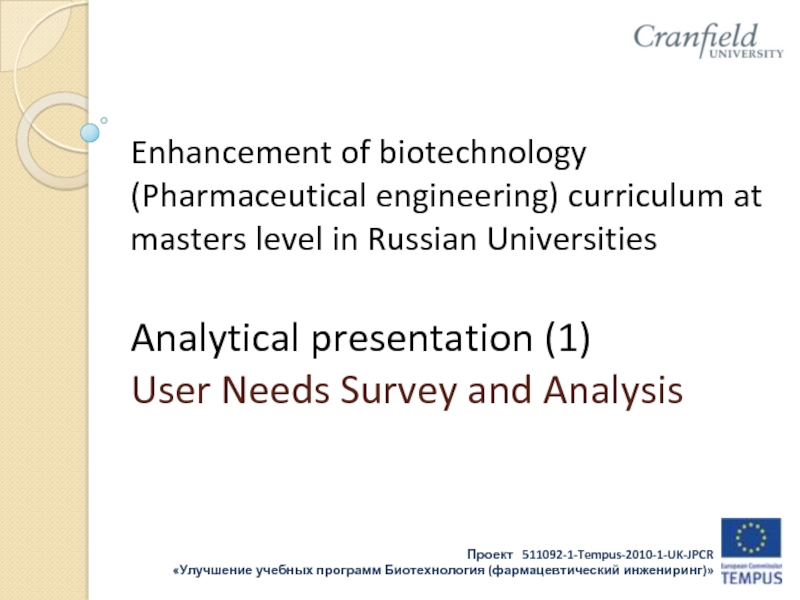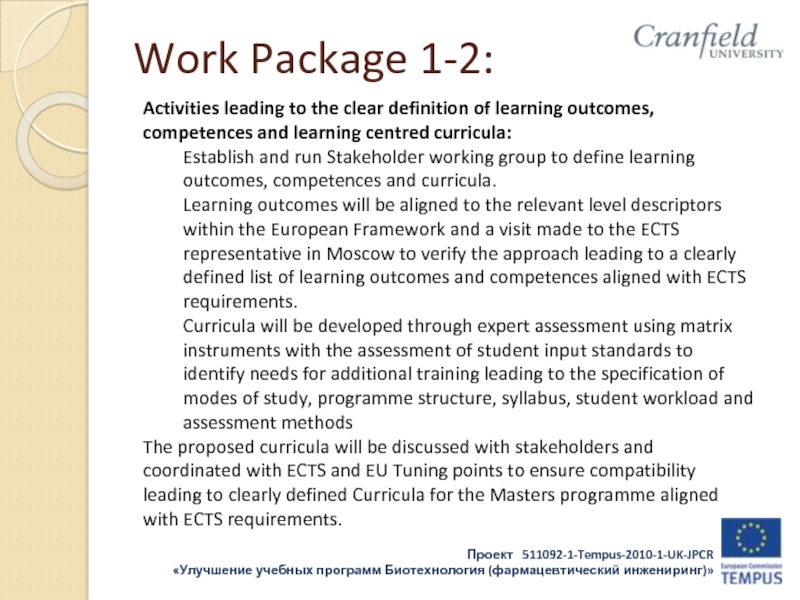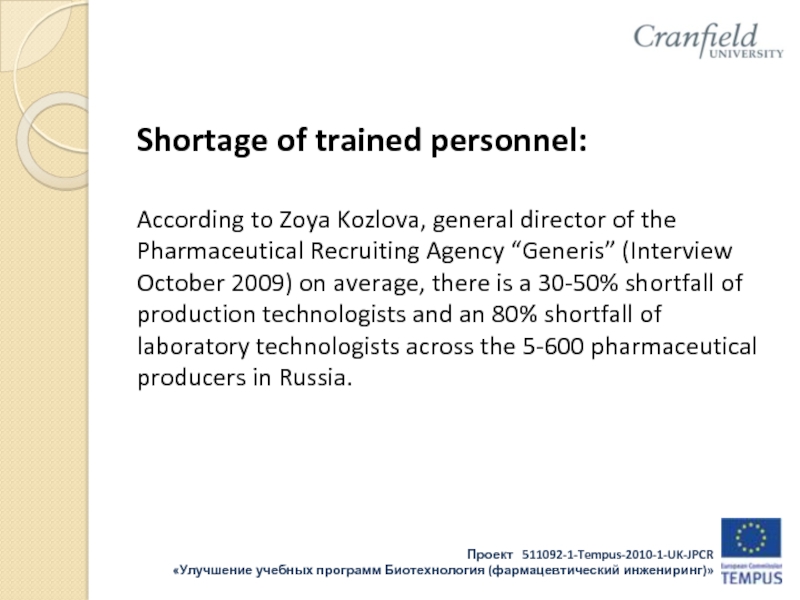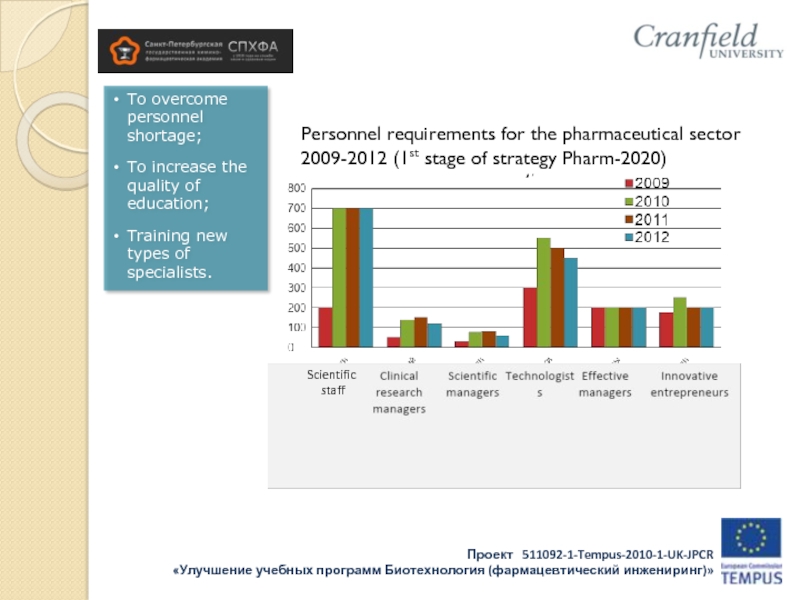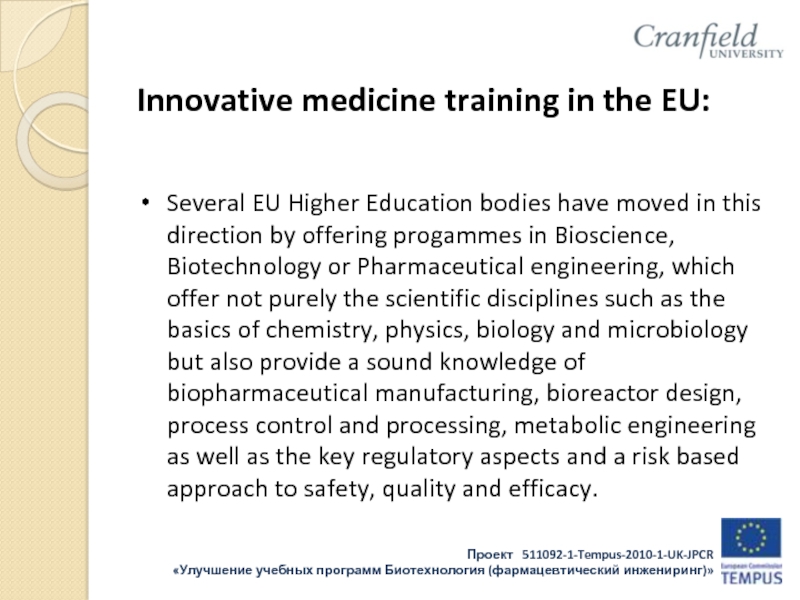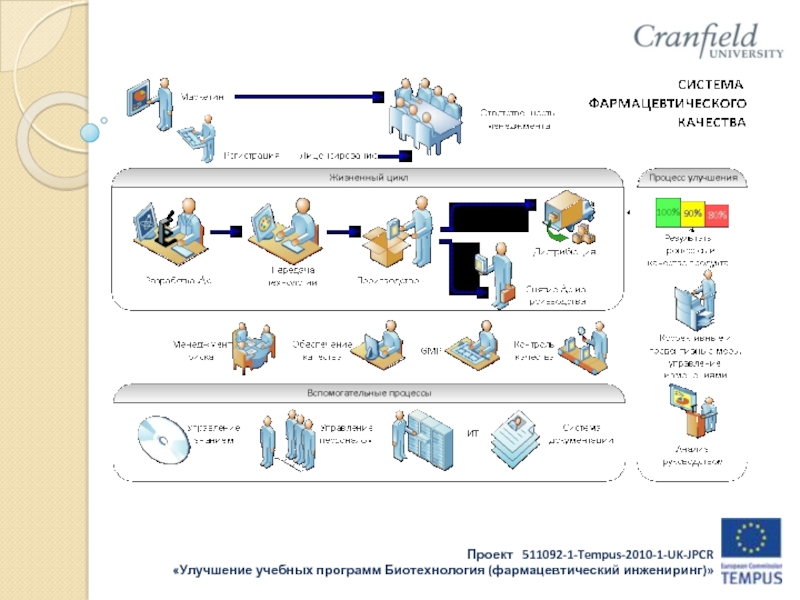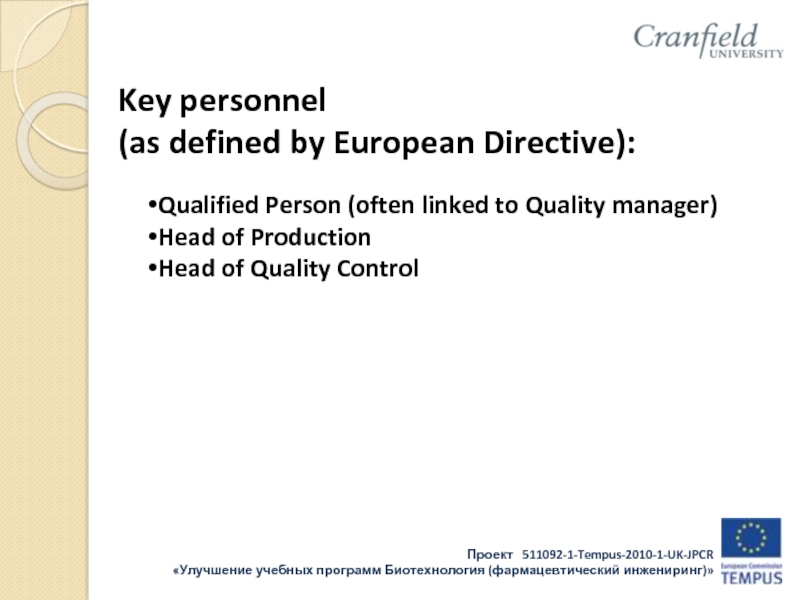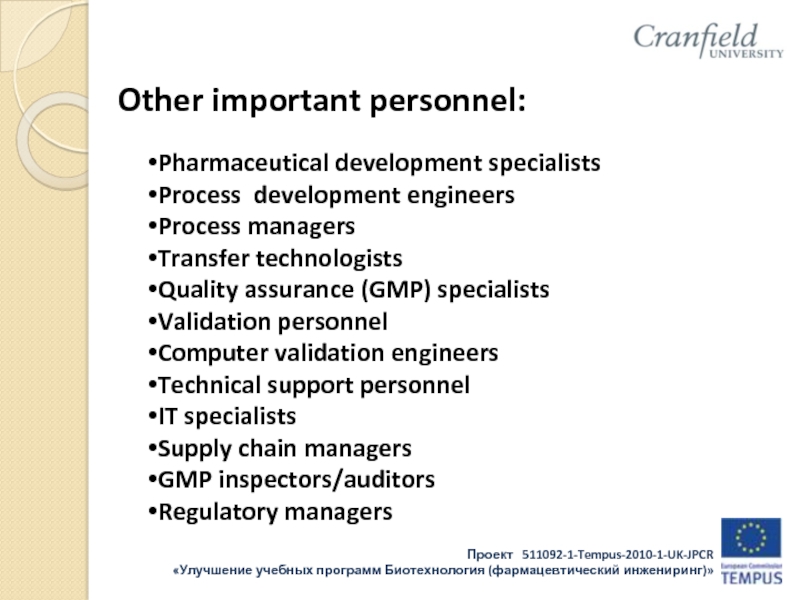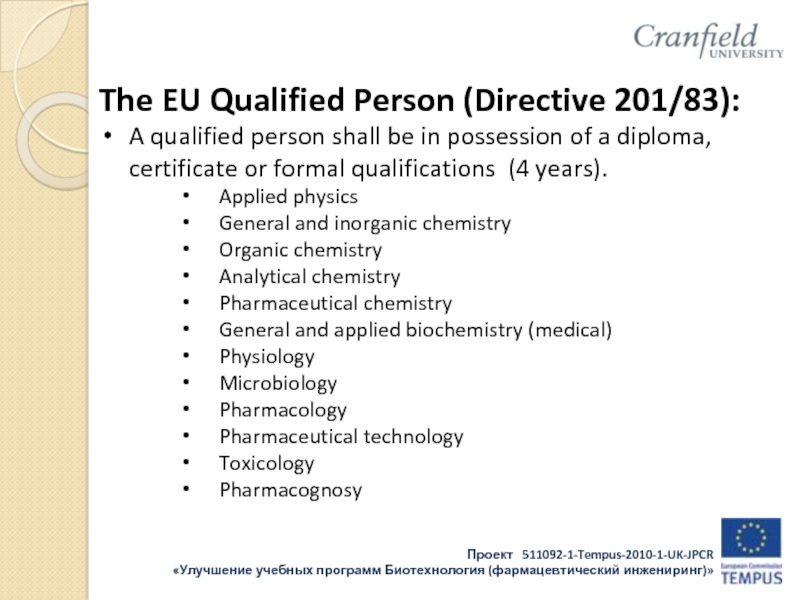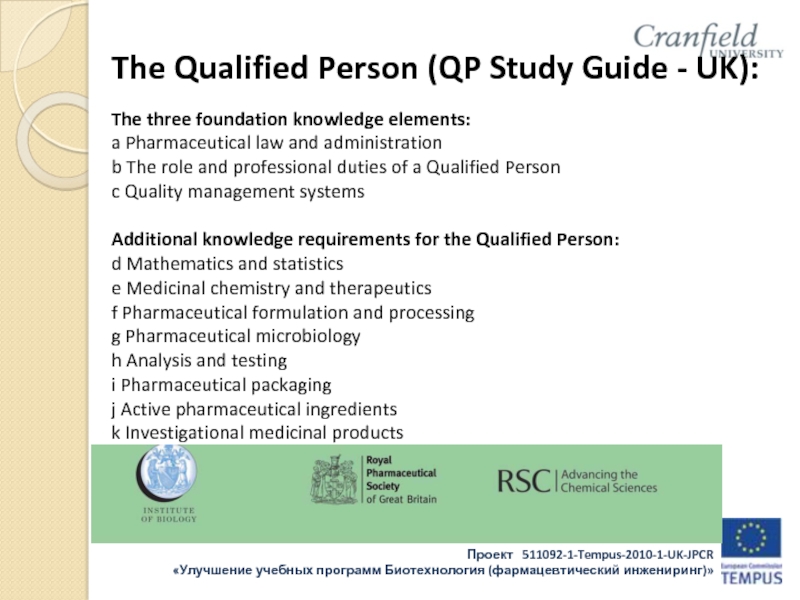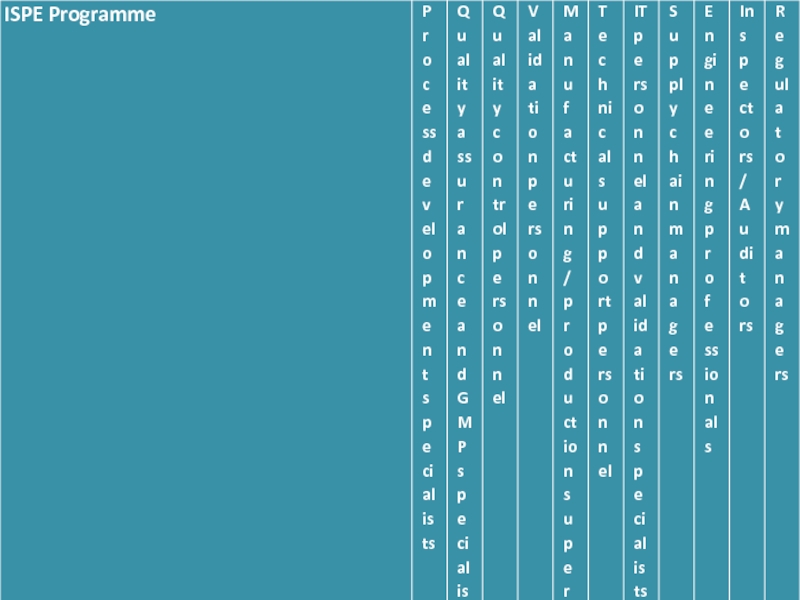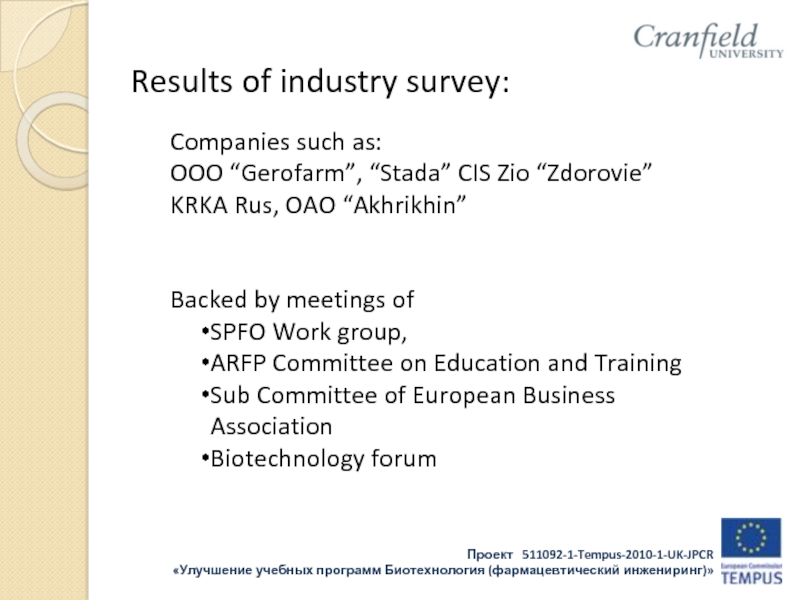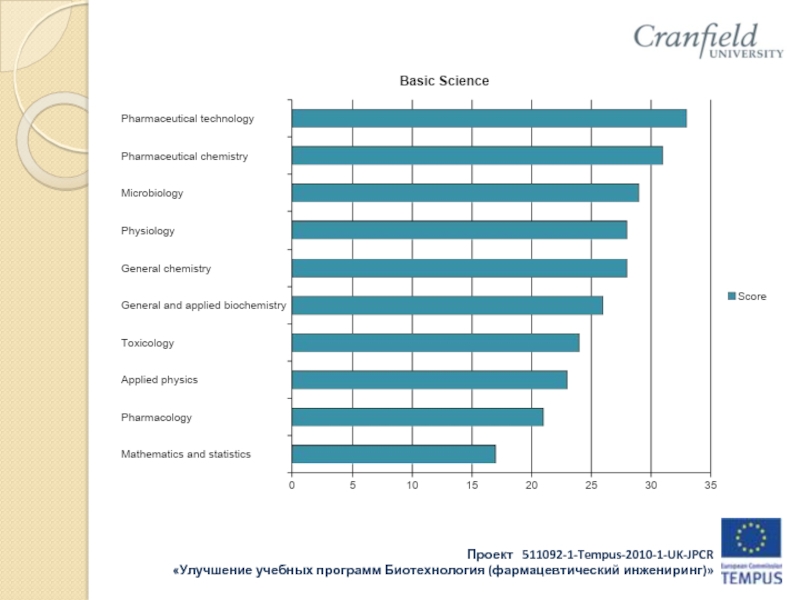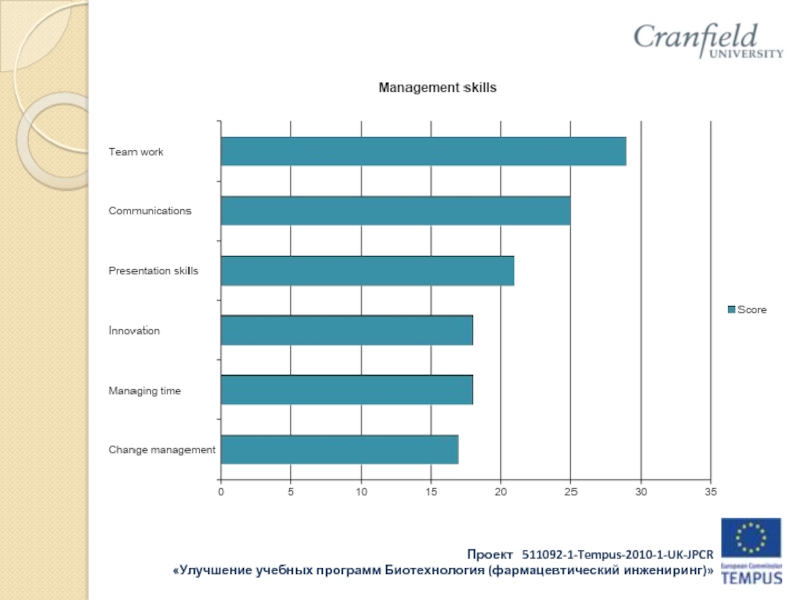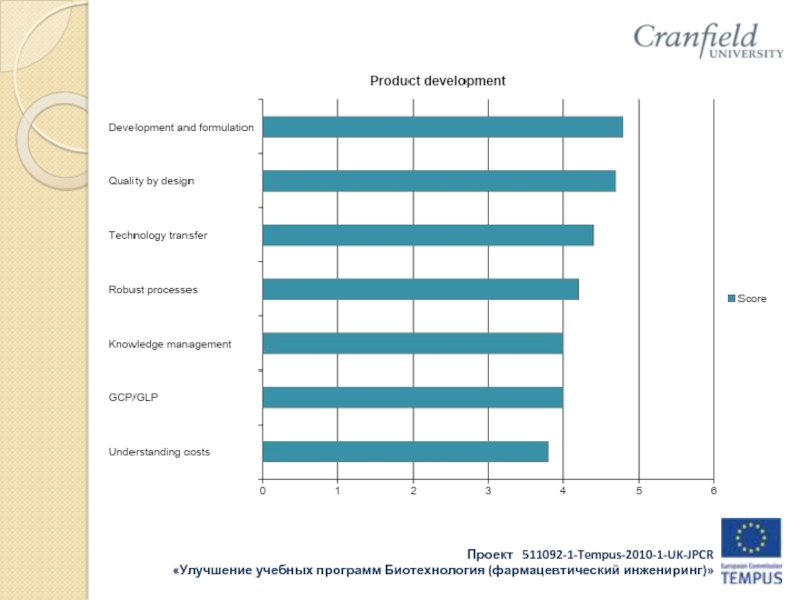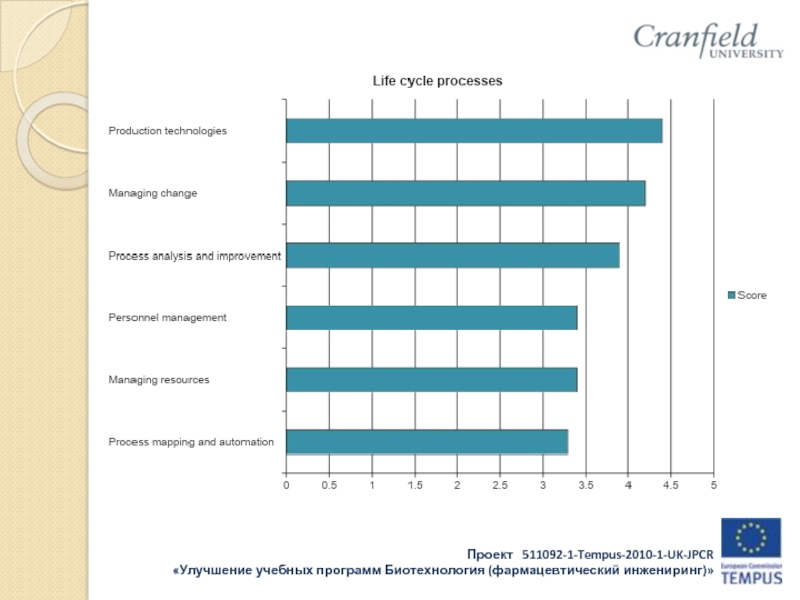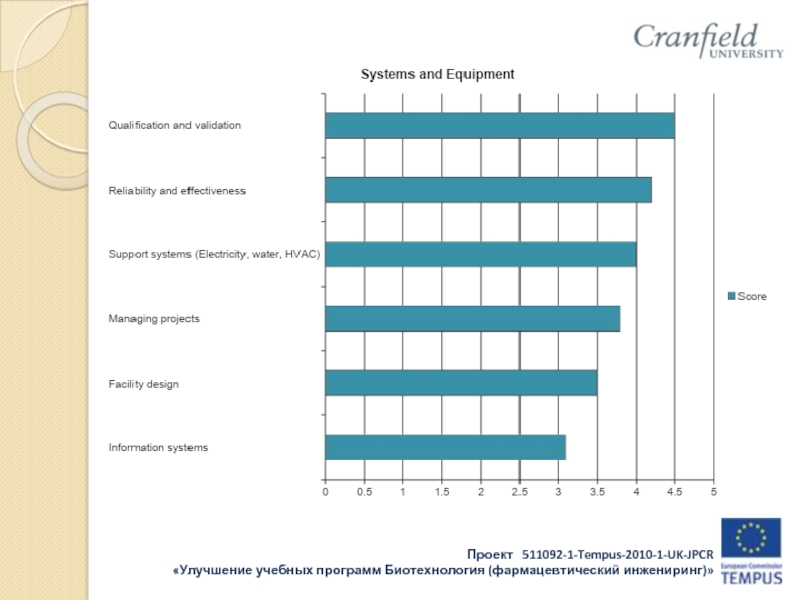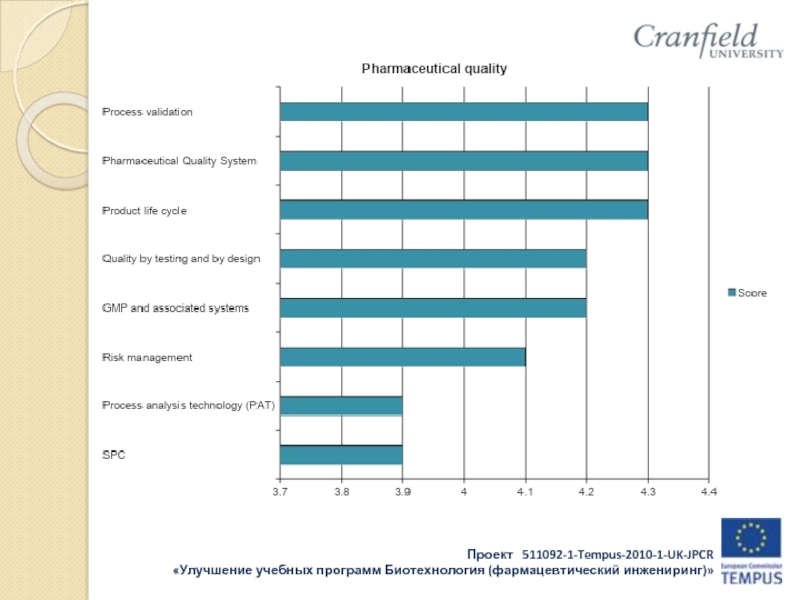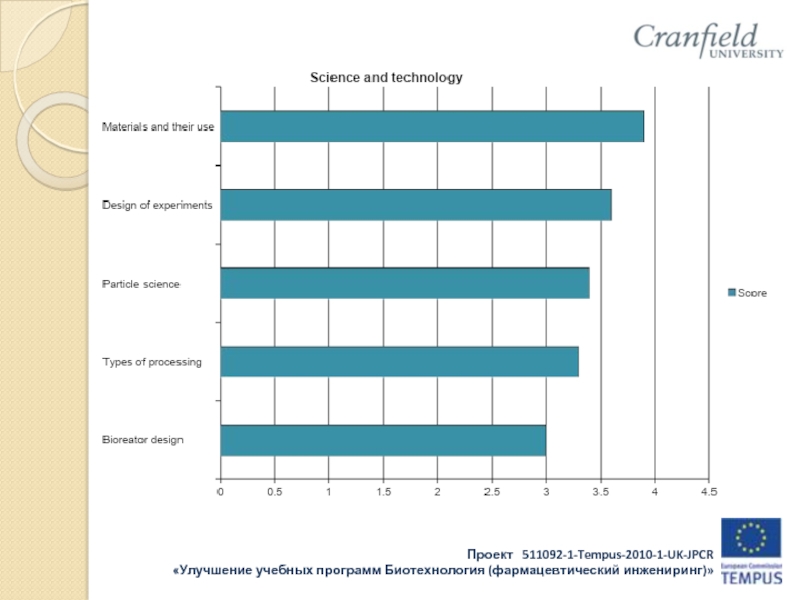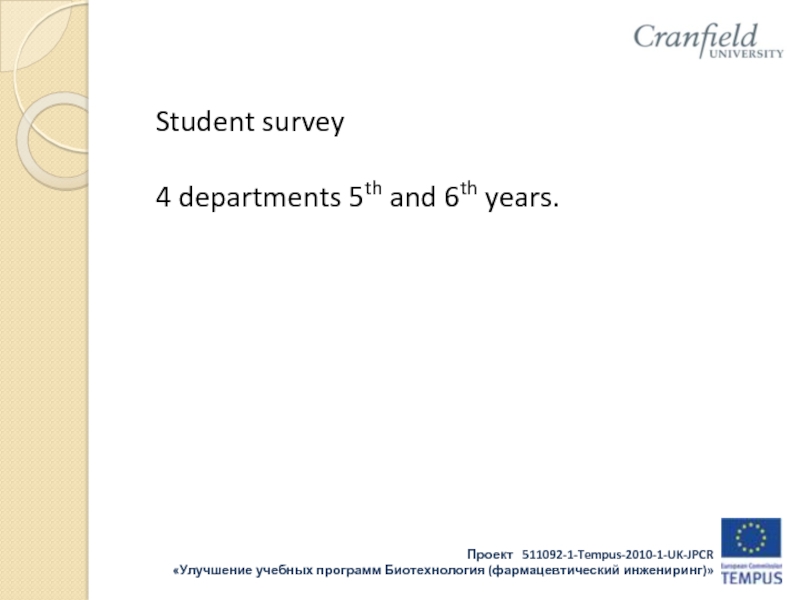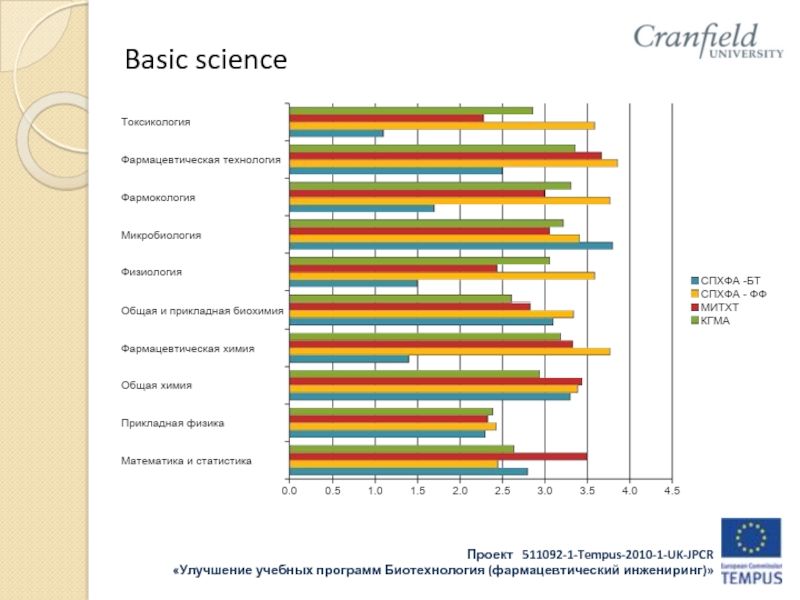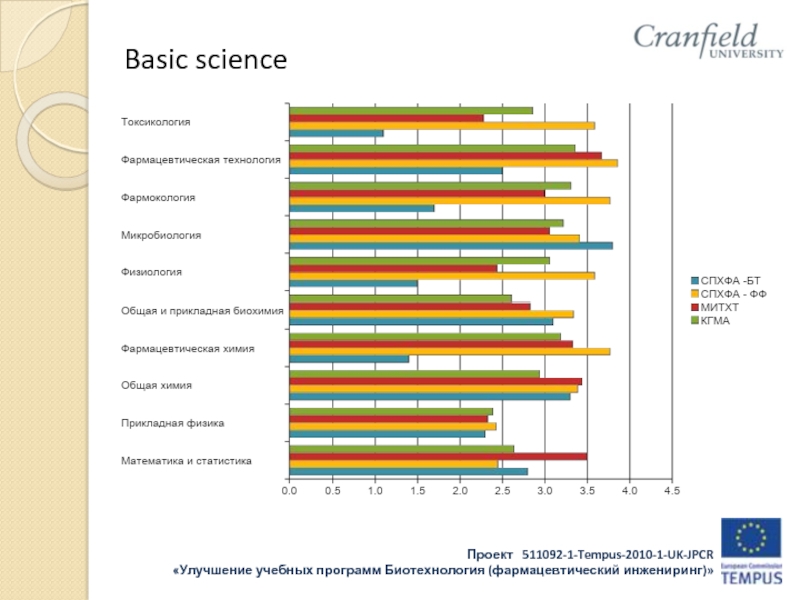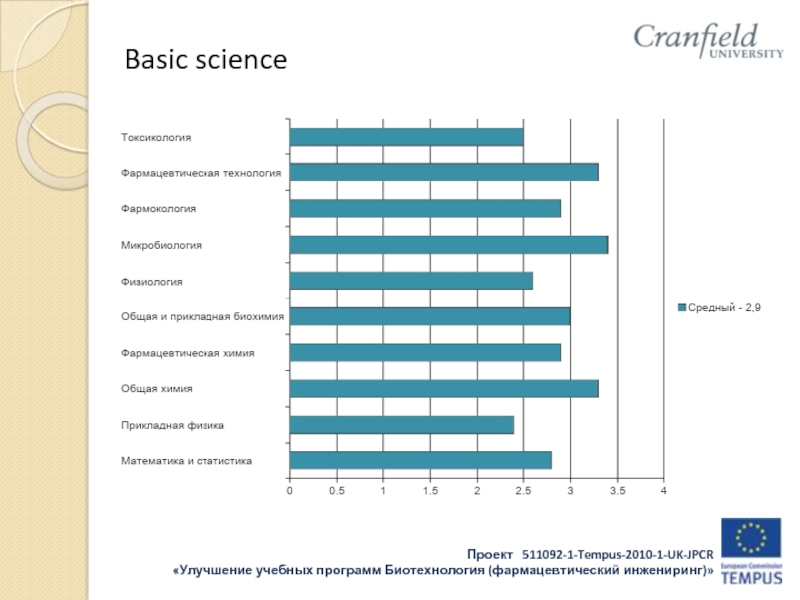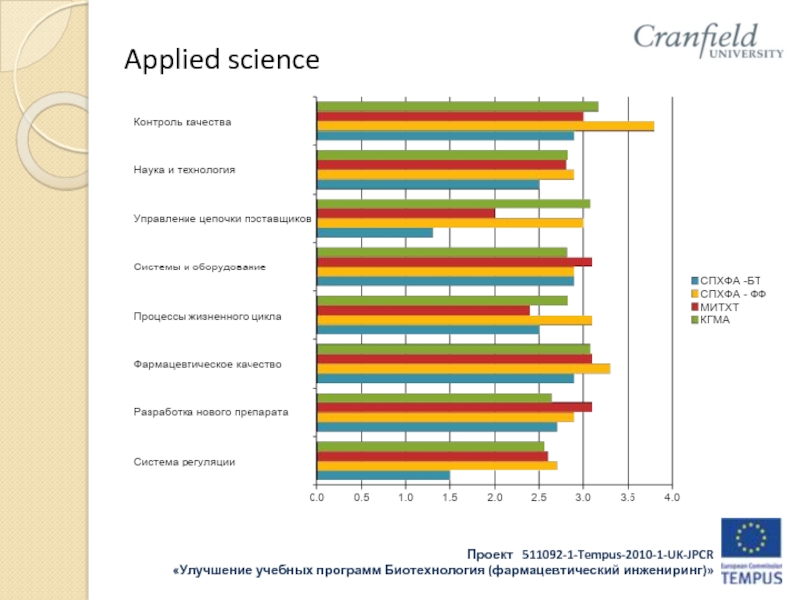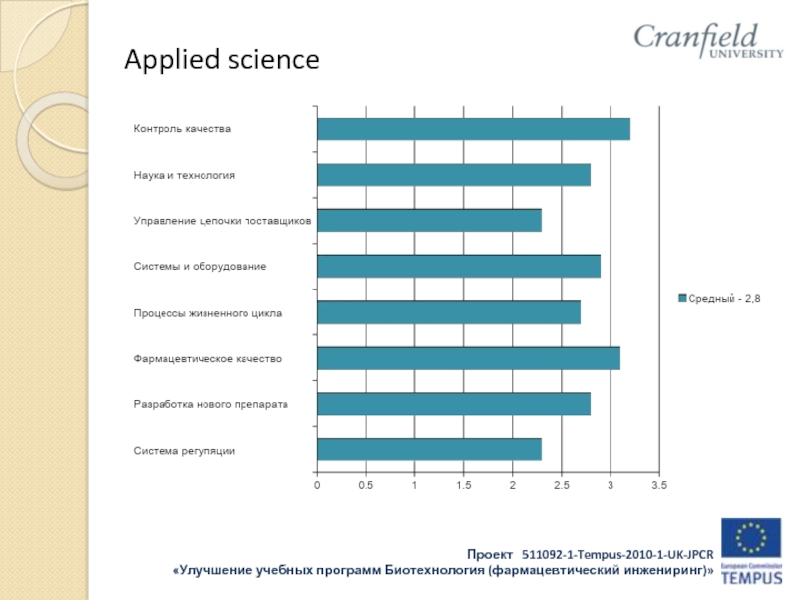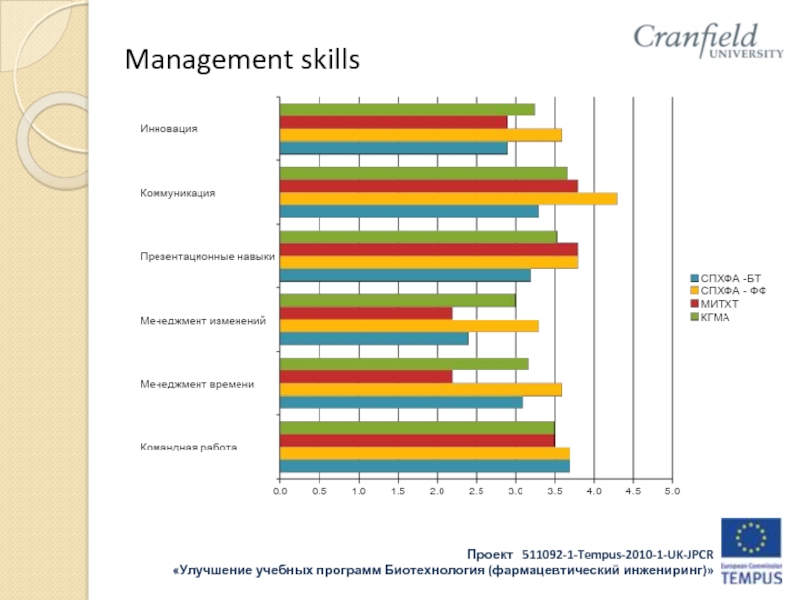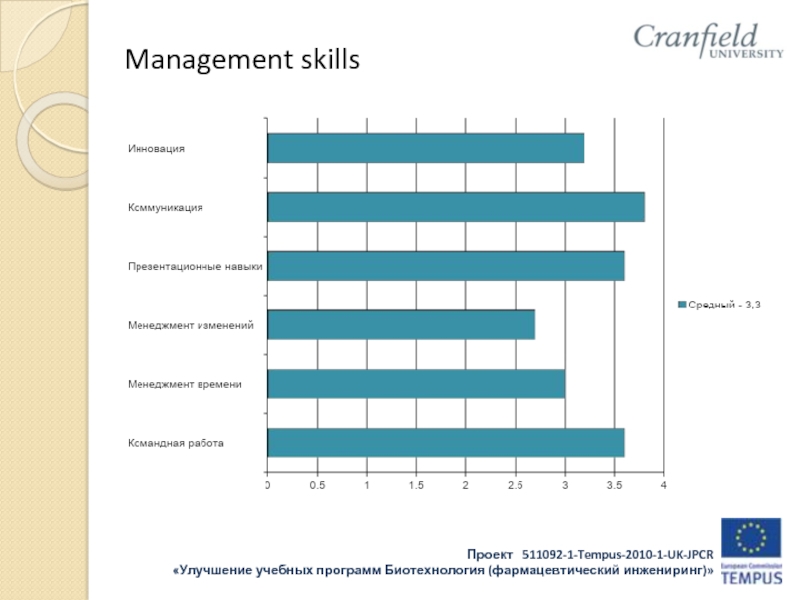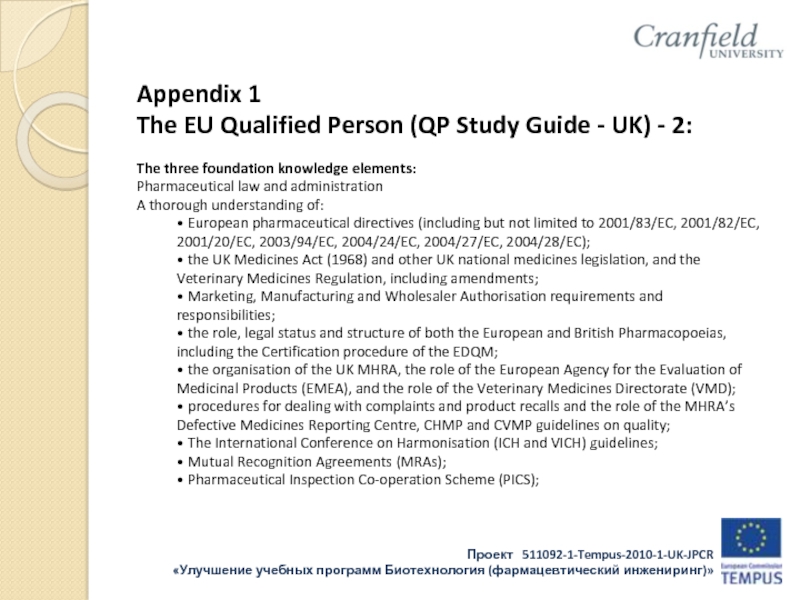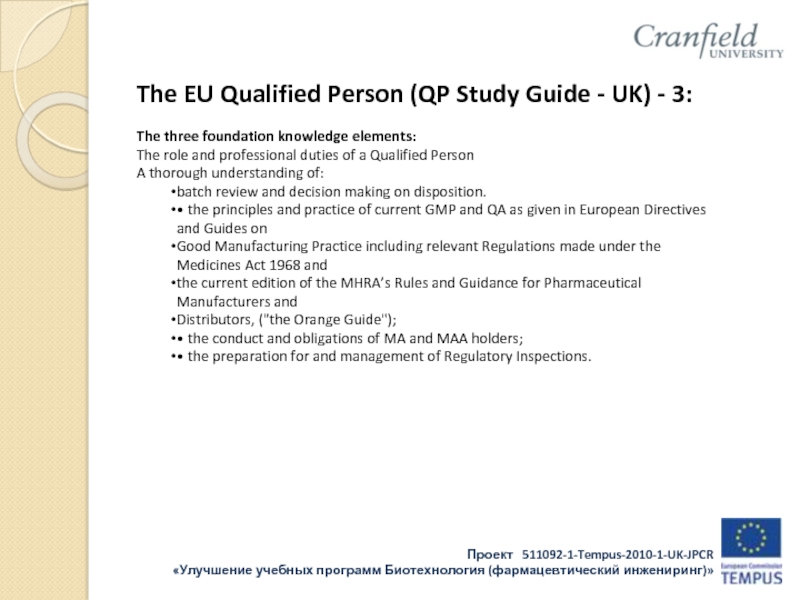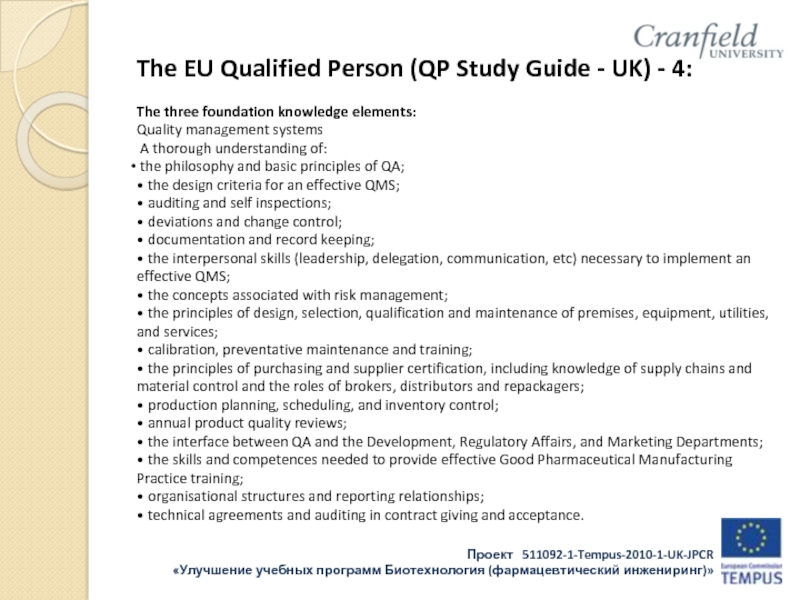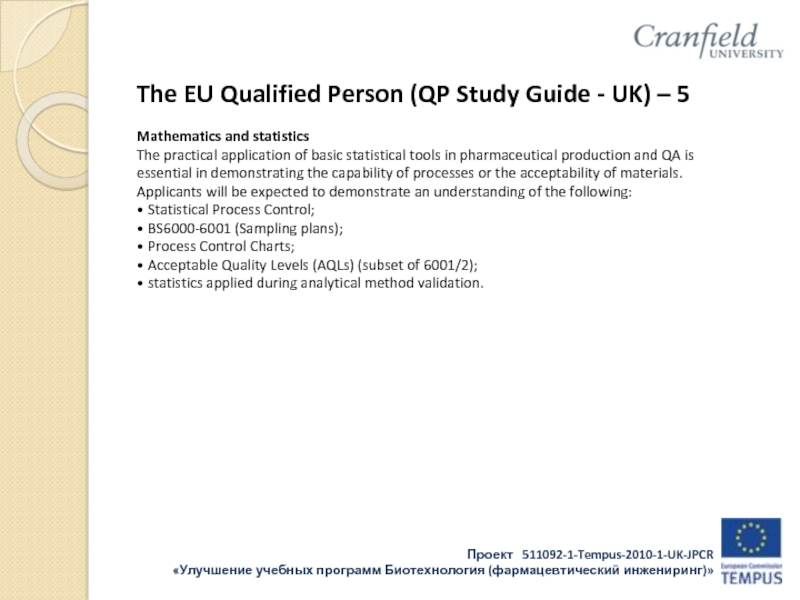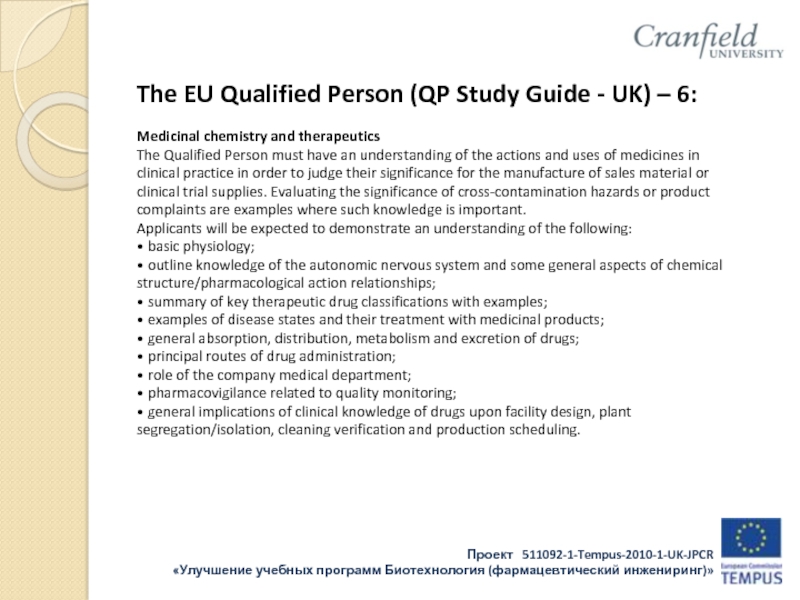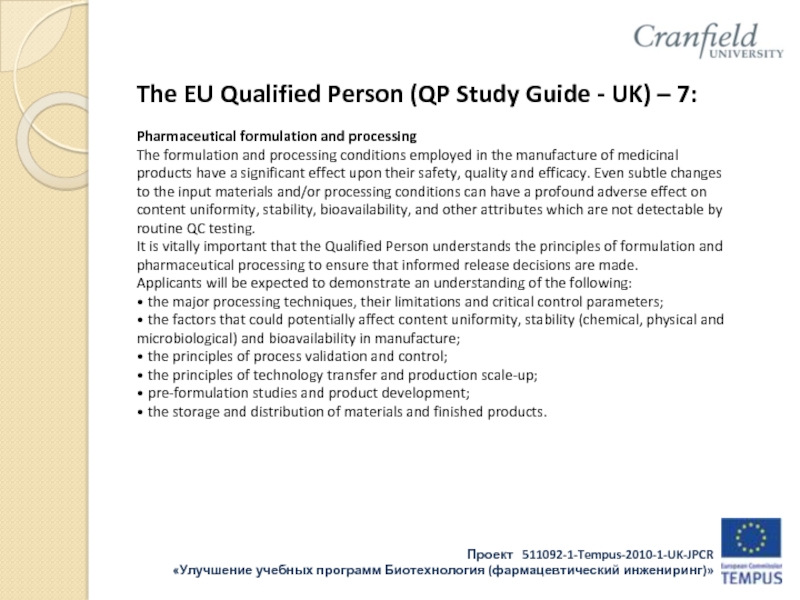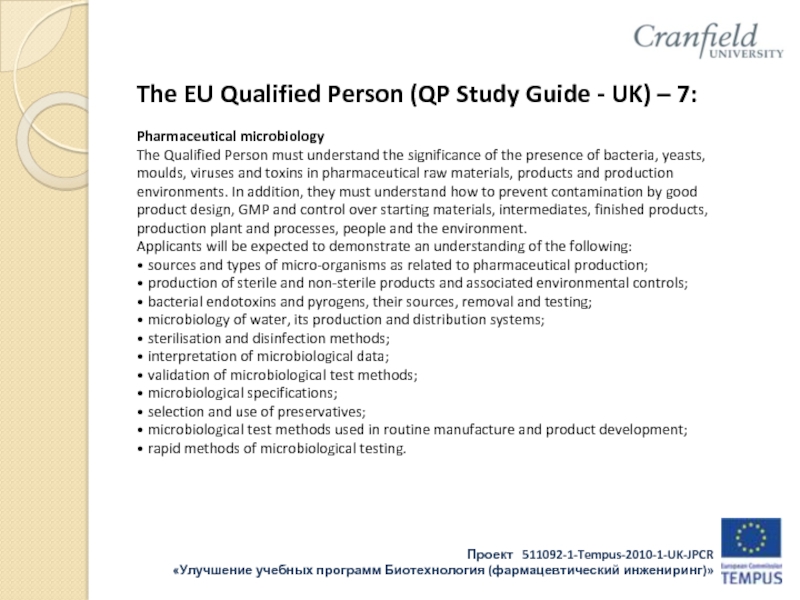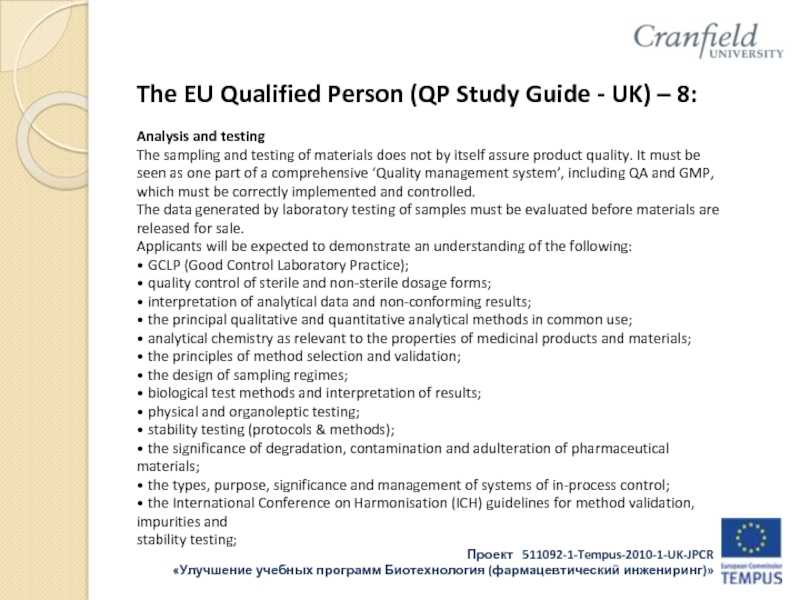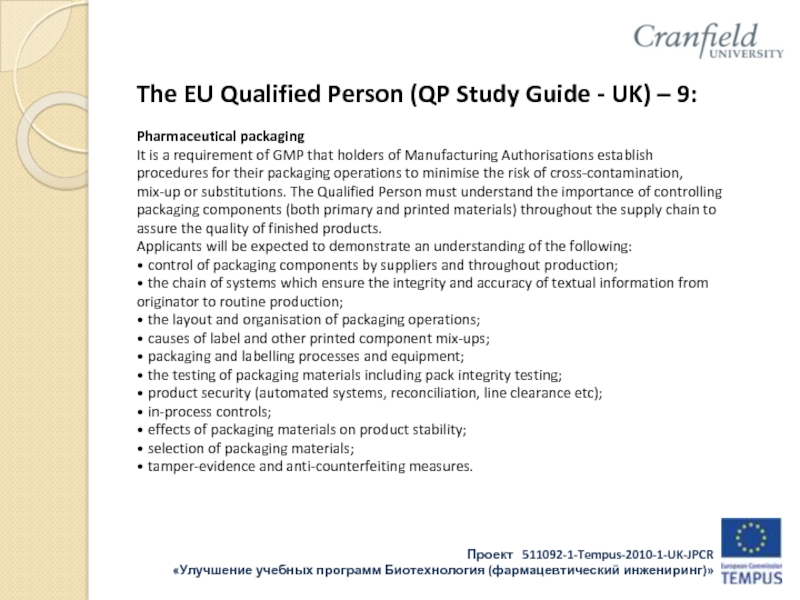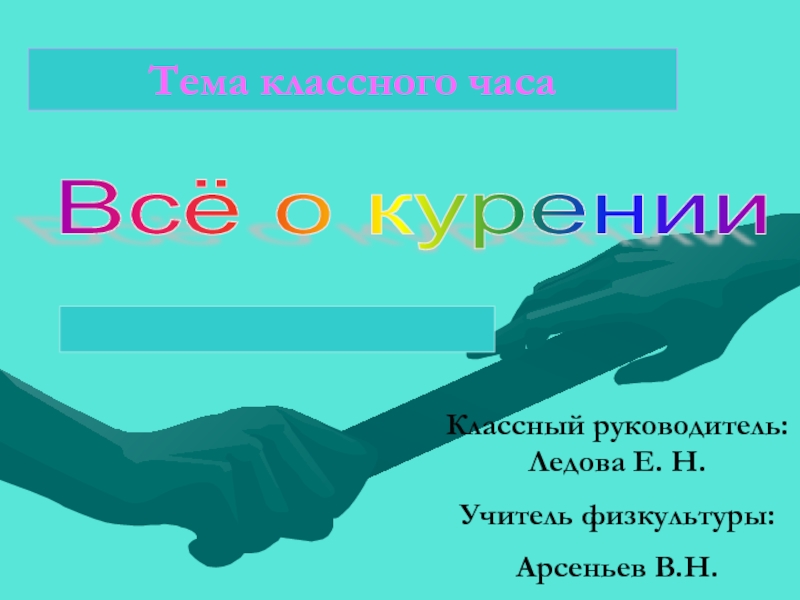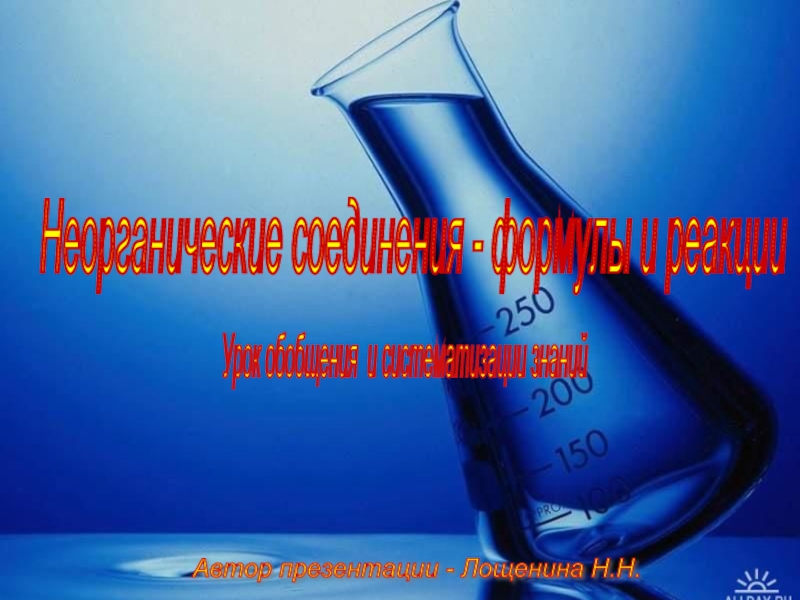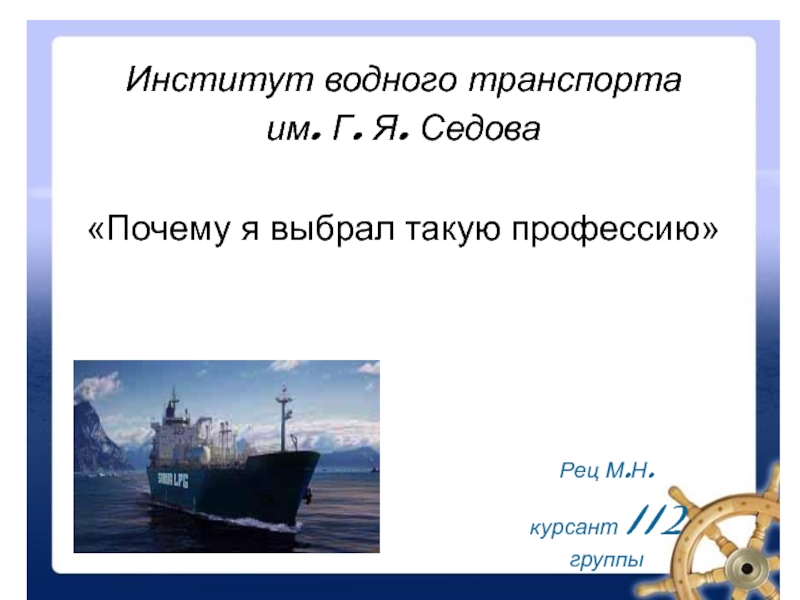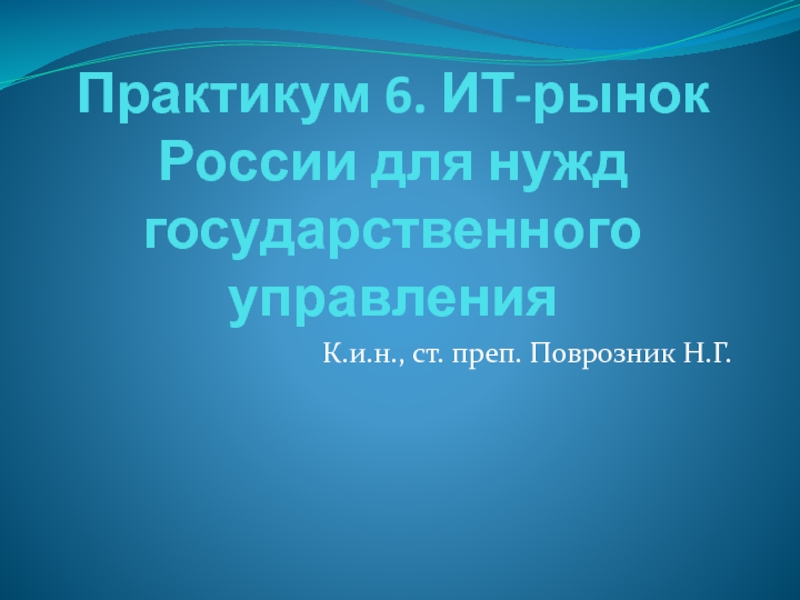Universities
Analytical presentation (1)
User Needs Survey and Analysis
- Главная
- Разное
- Дизайн
- Бизнес и предпринимательство
- Аналитика
- Образование
- Развлечения
- Красота и здоровье
- Финансы
- Государство
- Путешествия
- Спорт
- Недвижимость
- Армия
- Графика
- Культурология
- Еда и кулинария
- Лингвистика
- Английский язык
- Астрономия
- Алгебра
- Биология
- География
- Детские презентации
- Информатика
- История
- Литература
- Маркетинг
- Математика
- Медицина
- Менеджмент
- Музыка
- МХК
- Немецкий язык
- ОБЖ
- Обществознание
- Окружающий мир
- Педагогика
- Русский язык
- Технология
- Физика
- Философия
- Химия
- Шаблоны, картинки для презентаций
- Экология
- Экономика
- Юриспруденция
Enhancement of biotechnology (Pharmaceutical engineering) curriculum at masters level in Russian UniversitiesAnalytical presentation (1)User Needs Survey and Analysis презентация
Содержание
- 1. Enhancement of biotechnology (Pharmaceutical engineering) curriculum at masters level in Russian UniversitiesAnalytical presentation (1)User Needs Survey and Analysis
- 2. Work Package 1-2: Activities leading to the
- 3. Biotechnology – a priority in EU and
- 4. Shortage of trained personnel: According
- 5. To overcome personnel shortage; To increase the
- 6. To train: 6-10000 production specialists; 4-9000 R&D specialists.
- 7. Innovative medicine training in the EU:
- 10. Regulatory environment: International:
- 11. Key personnel (as defined by European
- 12. Other important personnel: Pharmaceutical development specialists
- 13. The EU Qualified Person (Directive 201/83):
- 14. The Qualified Person (QP Study Guide -
- 16. Results of industry survey: Companies such
- 28. Student survey 4 departments 5th and 6th years.
- 29. Basic science
- 30. Basic science
- 31. Basic science
- 32. Applied science
- 33. Applied science
- 34. Management skills
- 35. Management skills
- 36. Comparison – basic science
- 37. Appendix 1 The EU Qualified Person (QP
- 38. The EU Qualified Person (QP Study Guide
- 39. The EU Qualified Person (QP Study Guide
- 40. The EU Qualified Person (QP Study Guide
- 41. The EU Qualified Person (QP Study Guide
- 42. The EU Qualified Person (QP Study Guide
- 43. The EU Qualified Person (QP Study Guide
- 44. The EU Qualified Person (QP Study Guide
- 45. The EU Qualified Person (QP Study Guide
- 46. The EU Qualified Person (QP Study Guide
- 47. The EU Qualified Person (QP Study Guide
Слайд 1Enhancement of biotechnology (Pharmaceutical engineering) curriculum at masters level in Russian
Слайд 2Work Package 1-2:
Activities leading to the clear definition of learning outcomes,
competences and learning centred curricula:
Establish and run Stakeholder working group to define learning outcomes, competences and curricula.
Learning outcomes will be aligned to the relevant level descriptors within the European Framework and a visit made to the ECTS representative in Moscow to verify the approach leading to a clearly defined list of learning outcomes and competences aligned with ECTS requirements.
Curricula will be developed through expert assessment using matrix instruments with the assessment of student input standards to identify needs for additional training leading to the specification of modes of study, programme structure, syllabus, student workload and assessment methods
The proposed curricula will be discussed with stakeholders and coordinated with ECTS and EU Tuning points to ensure compatibility leading to clearly defined Curricula for the Masters programme aligned with ECTS requirements.
Establish and run Stakeholder working group to define learning outcomes, competences and curricula.
Learning outcomes will be aligned to the relevant level descriptors within the European Framework and a visit made to the ECTS representative in Moscow to verify the approach leading to a clearly defined list of learning outcomes and competences aligned with ECTS requirements.
Curricula will be developed through expert assessment using matrix instruments with the assessment of student input standards to identify needs for additional training leading to the specification of modes of study, programme structure, syllabus, student workload and assessment methods
The proposed curricula will be discussed with stakeholders and coordinated with ECTS and EU Tuning points to ensure compatibility leading to clearly defined Curricula for the Masters programme aligned with ECTS requirements.
Слайд 3Biotechnology – a priority in EU and RF:
A thematic area (along
with health) in the EU’s Seventh Framework Programme for Research and Technological Development (2007-2013)
A top priority in the Russian government’s “Concept of Long Term Social and Economic Development till 2020”.
Tempus IV National Priorities - curriculum development in biotechnology.
Russian government priority - the modernization of industry paying special attention to producing safe and accessible pharmaceutical products for the Russian market.
A top priority in the Russian government’s “Concept of Long Term Social and Economic Development till 2020”.
Tempus IV National Priorities - curriculum development in biotechnology.
Russian government priority - the modernization of industry paying special attention to producing safe and accessible pharmaceutical products for the Russian market.
Слайд 4Shortage of trained personnel:
According to Zoya Kozlova, general director of
the Pharmaceutical Recruiting Agency “Generis” (Interview October 2009) on average, there is a 30-50% shortfall of production technologists and an 80% shortfall of laboratory technologists across the 5-600 pharmaceutical producers in Russia.
Слайд 5To overcome personnel shortage;
To increase the quality of education;
Training new types
of specialists.
Personnel requirements for the pharmaceutical sector 2009-2012 (1st stage of strategy Pharm-2020)
Scientific
staff
Слайд 7Innovative medicine training in the EU:
Several EU Higher Education bodies have
moved in this direction by offering progammes in Bioscience, Biotechnology or Pharmaceutical engineering, which offer not purely the scientific disciplines such as the basics of chemistry, physics, biology and microbiology but also provide a sound knowledge of biopharmaceutical manufacturing, bioreactor design, process control and processing, metabolic engineering as well as the key regulatory aspects and a risk based approach to safety, quality and efficacy.
Слайд 10Regulatory environment: International: WHO, FDA, European Directives and
national systems
Harmonised structures through the life cycle through
such organisations as PIC/S, EMA, EDQM
Russian:
Ministries of Health, Education, Industry
RosZdravNadzor
Слайд 11Key personnel
(as defined by European Directive):
Qualified Person (often linked to
Quality manager)
Head of Production
Head of Quality Control
Head of Production
Head of Quality Control
Слайд 12Other important personnel:
Pharmaceutical development specialists
Process development engineers
Process managers
Transfer technologists
Quality assurance (GMP)
specialists
Validation personnel
Computer validation engineers
Technical support personnel
IT specialists
Supply chain managers
GMP inspectors/auditors
Regulatory managers
Validation personnel
Computer validation engineers
Technical support personnel
IT specialists
Supply chain managers
GMP inspectors/auditors
Regulatory managers
Слайд 13The EU Qualified Person (Directive 201/83):
A qualified person shall be
in possession of a diploma, certificate or formal qualifications (4 years).
Applied physics
General and inorganic chemistry
Organic chemistry
Analytical chemistry
Pharmaceutical chemistry
General and applied biochemistry (medical)
Physiology
Microbiology
Pharmacology
Pharmaceutical technology
Toxicology
Pharmacognosy
Applied physics
General and inorganic chemistry
Organic chemistry
Analytical chemistry
Pharmaceutical chemistry
General and applied biochemistry (medical)
Physiology
Microbiology
Pharmacology
Pharmaceutical technology
Toxicology
Pharmacognosy
Слайд 14The Qualified Person (QP Study Guide - UK):
The three foundation
knowledge elements:
a Pharmaceutical law and administration
b The role and professional duties of a Qualified Person
c Quality management systems
Additional knowledge requirements for the Qualified Person:
d Mathematics and statistics
e Medicinal chemistry and therapeutics
f Pharmaceutical formulation and processing
g Pharmaceutical microbiology
h Analysis and testing
i Pharmaceutical packaging
j Active pharmaceutical ingredients
k Investigational medicinal products
a Pharmaceutical law and administration
b The role and professional duties of a Qualified Person
c Quality management systems
Additional knowledge requirements for the Qualified Person:
d Mathematics and statistics
e Medicinal chemistry and therapeutics
f Pharmaceutical formulation and processing
g Pharmaceutical microbiology
h Analysis and testing
i Pharmaceutical packaging
j Active pharmaceutical ingredients
k Investigational medicinal products
Слайд 16Results of industry survey:
Companies such as:
OOO “Gerofarm”, “Stada” CIS Zio “Zdorovie”
KRKA
Rus, OAO “Akhrikhin”
Backed by meetings of
SPFO Work group,
ARFP Committee on Education and Training
Sub Committee of European Business Association
Biotechnology forum
Backed by meetings of
SPFO Work group,
ARFP Committee on Education and Training
Sub Committee of European Business Association
Biotechnology forum
Слайд 37Appendix 1
The EU Qualified Person (QP Study Guide - UK) -
2:
The three foundation knowledge elements:
Pharmaceutical law and administration
A thorough understanding of:
• European pharmaceutical directives (including but not limited to 2001/83/EC, 2001/82/EC,
2001/20/EC, 2003/94/EC, 2004/24/EC, 2004/27/EC, 2004/28/EC);
• the UK Medicines Act (1968) and other UK national medicines legislation, and the Veterinary Medicines Regulation, including amendments;
• Marketing, Manufacturing and Wholesaler Authorisation requirements and
responsibilities;
• the role, legal status and structure of both the European and British Pharmacopoeias,
including the Certification procedure of the EDQM;
• the organisation of the UK MHRA, the role of the European Agency for the Evaluation of Medicinal Products (EMEA), and the role of the Veterinary Medicines Directorate (VMD);
• procedures for dealing with complaints and product recalls and the role of the MHRA’s Defective Medicines Reporting Centre, CHMP and CVMP guidelines on quality;
• The International Conference on Harmonisation (ICH and VICH) guidelines;
• Mutual Recognition Agreements (MRAs);
• Pharmaceutical Inspection Co-operation Scheme (PICS);
The three foundation knowledge elements:
Pharmaceutical law and administration
A thorough understanding of:
• European pharmaceutical directives (including but not limited to 2001/83/EC, 2001/82/EC,
2001/20/EC, 2003/94/EC, 2004/24/EC, 2004/27/EC, 2004/28/EC);
• the UK Medicines Act (1968) and other UK national medicines legislation, and the Veterinary Medicines Regulation, including amendments;
• Marketing, Manufacturing and Wholesaler Authorisation requirements and
responsibilities;
• the role, legal status and structure of both the European and British Pharmacopoeias,
including the Certification procedure of the EDQM;
• the organisation of the UK MHRA, the role of the European Agency for the Evaluation of Medicinal Products (EMEA), and the role of the Veterinary Medicines Directorate (VMD);
• procedures for dealing with complaints and product recalls and the role of the MHRA’s Defective Medicines Reporting Centre, CHMP and CVMP guidelines on quality;
• The International Conference on Harmonisation (ICH and VICH) guidelines;
• Mutual Recognition Agreements (MRAs);
• Pharmaceutical Inspection Co-operation Scheme (PICS);
Слайд 38The EU Qualified Person (QP Study Guide - UK) - 3:
The three foundation knowledge elements:
The role and professional duties of a Qualified Person
A thorough understanding of:
batch review and decision making on disposition.
• the principles and practice of current GMP and QA as given in European Directives and Guides on
Good Manufacturing Practice including relevant Regulations made under the Medicines Act 1968 and
the current edition of the MHRA’s Rules and Guidance for Pharmaceutical Manufacturers and
Distributors, ("the Orange Guide");
• the conduct and obligations of MA and MAA holders;
• the preparation for and management of Regulatory Inspections.
Слайд 39The EU Qualified Person (QP Study Guide - UK) - 4:
The three foundation knowledge elements:
Quality management systems
A thorough understanding of:
the philosophy and basic principles of QA;
• the design criteria for an effective QMS;
• auditing and self inspections;
• deviations and change control;
• documentation and record keeping;
• the interpersonal skills (leadership, delegation, communication, etc) necessary to implement an effective QMS;
• the concepts associated with risk management;
• the principles of design, selection, qualification and maintenance of premises, equipment, utilities, and services;
• calibration, preventative maintenance and training;
• the principles of purchasing and supplier certification, including knowledge of supply chains and material control and the roles of brokers, distributors and repackagers;
• production planning, scheduling, and inventory control;
• annual product quality reviews;
• the interface between QA and the Development, Regulatory Affairs, and Marketing Departments;
• the skills and competences needed to provide effective Good Pharmaceutical Manufacturing Practice training;
• organisational structures and reporting relationships;
• technical agreements and auditing in contract giving and acceptance.
Слайд 40The EU Qualified Person (QP Study Guide - UK) – 5
Mathematics
and statistics
The practical application of basic statistical tools in pharmaceutical production and QA is essential in demonstrating the capability of processes or the acceptability of materials.
Applicants will be expected to demonstrate an understanding of the following:
• Statistical Process Control;
• BS6000-6001 (Sampling plans);
• Process Control Charts;
• Acceptable Quality Levels (AQLs) (subset of 6001/2);
• statistics applied during analytical method validation.
The practical application of basic statistical tools in pharmaceutical production and QA is essential in demonstrating the capability of processes or the acceptability of materials.
Applicants will be expected to demonstrate an understanding of the following:
• Statistical Process Control;
• BS6000-6001 (Sampling plans);
• Process Control Charts;
• Acceptable Quality Levels (AQLs) (subset of 6001/2);
• statistics applied during analytical method validation.
Слайд 41The EU Qualified Person (QP Study Guide - UK) – 6:
Medicinal chemistry and therapeutics
The Qualified Person must have an understanding of the actions and uses of medicines in clinical practice in order to judge their significance for the manufacture of sales material or clinical trial supplies. Evaluating the significance of cross-contamination hazards or product complaints are examples where such knowledge is important.
Applicants will be expected to demonstrate an understanding of the following:
• basic physiology;
• outline knowledge of the autonomic nervous system and some general aspects of chemical
structure/pharmacological action relationships;
• summary of key therapeutic drug classifications with examples;
• examples of disease states and their treatment with medicinal products;
• general absorption, distribution, metabolism and excretion of drugs;
• principal routes of drug administration;
• role of the company medical department;
• pharmacovigilance related to quality monitoring;
• general implications of clinical knowledge of drugs upon facility design, plant segregation/isolation, cleaning verification and production scheduling.
Слайд 42The EU Qualified Person (QP Study Guide - UK) – 7:
Pharmaceutical formulation and processing
The formulation and processing conditions employed in the manufacture of medicinal products have a significant effect upon their safety, quality and efficacy. Even subtle changes to the input materials and/or processing conditions can have a profound adverse effect on content uniformity, stability, bioavailability, and other attributes which are not detectable by routine QC testing.
It is vitally important that the Qualified Person understands the principles of formulation and pharmaceutical processing to ensure that informed release decisions are made.
Applicants will be expected to demonstrate an understanding of the following:
• the major processing techniques, their limitations and critical control parameters;
• the factors that could potentially affect content uniformity, stability (chemical, physical and
microbiological) and bioavailability in manufacture;
• the principles of process validation and control;
• the principles of technology transfer and production scale-up;
• pre-formulation studies and product development;
• the storage and distribution of materials and finished products.
Слайд 43The EU Qualified Person (QP Study Guide - UK) – 7:
Pharmaceutical microbiology
The Qualified Person must understand the significance of the presence of bacteria, yeasts, moulds, viruses and toxins in pharmaceutical raw materials, products and production environments. In addition, they must understand how to prevent contamination by good product design, GMP and control over starting materials, intermediates, finished products, production plant and processes, people and the environment.
Applicants will be expected to demonstrate an understanding of the following:
• sources and types of micro-organisms as related to pharmaceutical production;
• production of sterile and non-sterile products and associated environmental controls;
• bacterial endotoxins and pyrogens, their sources, removal and testing;
• microbiology of water, its production and distribution systems;
• sterilisation and disinfection methods;
• interpretation of microbiological data;
• validation of microbiological test methods;
• microbiological specifications;
• selection and use of preservatives;
• microbiological test methods used in routine manufacture and product development;
• rapid methods of microbiological testing.
Слайд 44The EU Qualified Person (QP Study Guide - UK) – 8:
Analysis and testing
The sampling and testing of materials does not by itself assure product quality. It must be seen as one part of a comprehensive ‘Quality management system’, including QA and GMP, which must be correctly implemented and controlled.
The data generated by laboratory testing of samples must be evaluated before materials are released for sale.
Applicants will be expected to demonstrate an understanding of the following:
• GCLP (Good Control Laboratory Practice);
• quality control of sterile and non-sterile dosage forms;
• interpretation of analytical data and non-conforming results;
• the principal qualitative and quantitative analytical methods in common use;
• analytical chemistry as relevant to the properties of medicinal products and materials;
• the principles of method selection and validation;
• the design of sampling regimes;
• biological test methods and interpretation of results;
• physical and organoleptic testing;
• stability testing (protocols & methods);
• the significance of degradation, contamination and adulteration of pharmaceutical materials;
• the types, purpose, significance and management of systems of in-process control;
• the International Conference on Harmonisation (ICH) guidelines for method validation, impurities and
stability testing;
Слайд 45The EU Qualified Person (QP Study Guide - UK) – 9:
Pharmaceutical packaging
It is a requirement of GMP that holders of Manufacturing Authorisations establish procedures for their packaging operations to minimise the risk of cross-contamination, mix-up or substitutions. The Qualified Person must understand the importance of controlling packaging components (both primary and printed materials) throughout the supply chain to assure the quality of finished products.
Applicants will be expected to demonstrate an understanding of the following:
• control of packaging components by suppliers and throughout production;
• the chain of systems which ensure the integrity and accuracy of textual information from originator to routine production;
• the layout and organisation of packaging operations;
• causes of label and other printed component mix-ups;
• packaging and labelling processes and equipment;
• the testing of packaging materials including pack integrity testing;
• product security (automated systems, reconciliation, line clearance etc);
• in-process controls;
• effects of packaging materials on product stability;
• selection of packaging materials;
• tamper-evidence and anti-counterfeiting measures.
Слайд 46The EU Qualified Person (QP Study Guide - UK) – 10:
Active pharmaceutical ingredients
The Qualified Person must understand the influence of manufacturing pathways and associated physical and physico-chemical attributes, of both active pharmaceutical ingredients and major excipients, on the quality of the finished dosage form.
Applicants will be expected to demonstrate an understanding of the following:
• the steps commonly taken in the manufacture of active pharmaceutical ingredients and excipients
(including biopharmaceuticals), their purpose and limitations;
• the generation of impurities, their identification, quantification, and elimination;
• the physico-chemical and biological properties of active pharmaceutical ingredients, and excipients, and
their effect on the attributes of the final dosage form;
• the specific requirements for bulk materials intended for sterile products;
• the nature of controls for the manufacture of bulk biological and biotech products;
• auditing of API manufacturers.
Слайд 47The EU Qualified Person (QP Study Guide - UK) – 11:
Investigational medicinal products
The manufacture, packaging and distribution of investigational medicinal products must be controlled. There are significant differences between the manufacture of IMPs and licensed dosage forms. The Qualified Person must understand these differences together with the safeguards required to assure the quality of IMP supply.
Applicants will be expected to demonstrate an understanding of the following:
• specific GMPs associated with the manufacture of investigational medicinal products;
• the control of active and placebo forms;
• the control of packaging operations and blinding;
• the control and release of imported IMPs;
• the control and release of comparators;
• effective batch documentation, sampling and batch release;
• change control and material traceability;
• controls surrounding the procurement of Clinical Trial (CT) supplies;
• the principles of clinical trial design and Good Clinical Practice (GCP).
